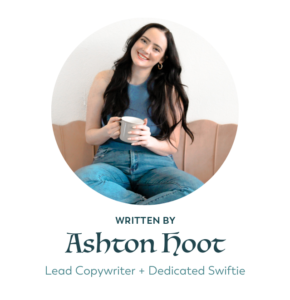Are you the type of person who freezes as soon as a camera’s “Recording” light blinks on? Do you hate public speaking? Because same.
I hated when my mom pulled out that chunky-ass video recorder and got all up in my face to record me doing the most random things.
Coloring my new Lisa Frank coloring book. Minding my own business jamming out to Britney Spears on my Walkman. Working on my Play-Doh replica of NASA. That woman was everywhere.
I think this is precisely where my camera phobia came from. I never knew what to say! I was self-conscious and overthinking every move because I knew I was being filmed.
And TBH, I still think this happens to many of us when it’s time to do things like record Reels, TikToks, or longer-form videos for YouTube and other platforms.
There’s so much pressure to perform that it’s easy to get tongue-tied and eventually find yourself completely off track or just giving up altogether. Recording video content is anything but easy, but that’s exactly where a video script for YouTube can help!
You can also use these tips for things like Reels and TikToks, although those are much less scripted and usually require less prep.
The benefits of a video script for YouTube
Even if you’re not the type to get stage fright, a script can be one of your greatest assets when making a YouTube video. There’s a lot going on — you have to make sure your camera is sitting at the right angle, that you don’t have any background noise, and that the files actually upload when you’re done filming…
YouTube videos are a lot.
But having a script can help you alleviate a lot of the pressure and help you stay focused on what you want to say.
So let’s take a look at how you can make the most of them and nail those YouTube videos!
Figure out who you’re talking to
You need to make sure you have your target audience narrowed down before you even get started with a YouTube script. Let’s be real: If you want your YouTube strategy to be strategic, your videos should talk to the same target audience you always speak to — or want to reach specifically. Don’t switch it up so you can do something like get more views or clicks.
When you don’t know who you’re talking to, it’s going to be really hard for people to know whether or not your content is for them…and your points/presentation will be all over the place.
Set a goal
Every video should have a goal or outcome. What do you want people to do after watching this video? Go to your website? Check out the resource links below? Watch another video?
Direct your audience to take action.
And even when you don’t want to add anything “salesy” in your videos because that’s not the vibe (like when you’re sharing a heartfelt personal story), you should still have an overarching goal. It might be more comments or subscribers. It might be more video retention.
Every piece of content, including your videos, should have a purpose, whether that’s brand awareness, forming a connection, or driving people to one of your offers.
Use an attention-grabbing hook
You don’t have to be clickbaity to grab people’s attention. In fact, we recommend that you don’t do that. It’s icky.
But that doesn’t mean it can’t add any pizzazz! Your video’s hooks and intros should be enticing enough to make people want more. It should be strong enough to grab attention and intentional enough to deliver the content your audience is looking for.
Plus, YouTube loves it when people stay and watch your videos. If you can get people to watch until the end, you’ll see your videos do much better!
Note from Latasha: Want an example of a great hook? Here’s a video you wouldn’t think would have a strong hook.
This guy starts out with a pic of Warren Buffett (like, what) but then he does something really smart: He says “Warren Buffett and other savvy business owners do this,” which automatically has those bros in the audience thinking, “Wait, I am a savvy business owner!” That draws them in.
Then he gets into the risks of NOT doing what he’s about to show you — 9 out 10 businesses fail because of financial mismanagement. Again, those bros are like “I’m gonna be the 1 out of 10!” *beats chest like caveman*
That’s a hook. You don’t have to do what he does, but we do recommend that you:
- Tell a story
- Share a stat
- Give them something to hang on for
Make your argument
Next up, it’s time to organize your main points. You want to make sure you cover all the bases, without getting TOO in the weeds.
The thing about YouTube? Your audience may want a short, sweet how-to over a long-form thesis on your area of experience. When you start with your topic, start by listing out the main points you have to cover. Once you have those points, write 2-3 sub-bullets to expand on them (or write full sentences — more on this in a second).
If you find that you have more than 5-6 points to cover and you have more to say than 2-3 subpoints, you might want to make your topic a series.
For example, we wrote a topic for our client, Anna Kornick, about the 7 types of late people. As we started scripting, we realized that she also had insights on how each of those types could stop being late. Not only did she have the 7 types, she had 7 solutions!
So guess what? We split that script into two videos so it kept her video time around the 5-6 minute mark.
Important: YouTube videos should be between 5 and 15 minutes. In our experience, our clients’ viewers want something closer to 5-7 minutes.
Don’t overscript yourself
The whole point of a YouTube script is to help you stay on track. You don’t have to read it word for word — even if you like to write a full-on word for word script.
We write YouTube and even podcast scripts for several of our clients, and they all have different ways they want them done. Some prefer bullet points with the main ideas, some prefer a full-on word-for-word script. Some prefer a mix, especially if we’re getting into launch territory and they need to talk about their offer OR so they nail the hook.
What works best for you depends on just that.
If you get overwhelmed with a long script and feel pressured to say it all, just go for the bullets. If you have a hard time thinking of words on the fly while you’re recording, a longer script may be the option for you.
There’s no one right way to do it as long as the content inside your video makes sense!
For the love of God, don’t read the script on screen
It’s important that you write in a clear, conversational, and natural style. We don’t usually recommend writing like you talk, but YouTube scripts are an exception! No one wants to listen to a boring speaker. Don’t act like you’re actually reading the script. Just be cool and casual.
Read your script out loud
It’s easy to skim over typos and sentences that don’t make a lot of sense when you’ve been writing and editing nonstop. If you’re ever stuck and want to be sure your script makes sense, read them out loud!
Doing this can also help you notice places where you stumble over and maybe need to add in some more detail. Or places that sound redundant, too long, or just straight-up awkward. Make this as important of a step as proofreading and editing.
Note from Latasha: I tell our clients to treat their script that like presentation they had to do in high school with flash cards. You have practiced the presentation in front of your parents and now you just have the flash cards as back-up.
We want you to know your content before you hit record. Don’t just write the script, forget everything you poured out, and then read your notes. Treat your script like flash cards.
Want to start a YouTube but need scripting help?
Don’t overthink this whole script thing. As long as you know what you want to say, how you want to say it, and where you want to direct your audience at the end, you’re going to do great!
But if you ever find that writing YouTube scripts, finding hooks, organizing your thoughts, and giving people a clear next step just isn’t your thing… we can help! Uncanny retainer clients get scripts for YouTube, podcast, and even Reels!
Looking for a full-service copy and content team (who can also help with YouTube scripts)? Give us a ring!

